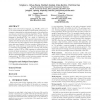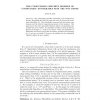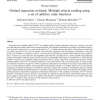148 search results - page 9 / 30 » Strong and Weak Policy Relations |
AE
2005
Springer
14 years 1 months ago
2005
Springer
Ligation is a form of chemical self-assembly that involves dynamic formation of strong covalent bonds in the presence of weak associative forces. We study an extremely simple form ...
SACMAT
2009
ACM
14 years 2 months ago
2009
ACM
Many access control policy languages, e.g., XACML, allow a policy to contain multiple sub-policies, and the result of the policy on a request is determined by combining the result...
ICPR
2006
IEEE
14 years 8 months ago
2006
IEEE
Recently, boosting is used widely in object detection applications because of its impressive performance in both speed and accuracy. However, learning weak classifiers which is on...
APAL
2010
13 years 7 months ago
2010
The computable Lipschitz reducibility was introduced by Downey, Hirschfeldt and LaForte under the name of strong weak truthtable reducibility [6]. This reducibility measures both t...
EOR
2008
13 years 7 months ago
2008
We present a new method, called UTAGMS , for multiple criteria ranking of alternatives from set A using a set of additive value functions which result from an ordinal regression. ...



